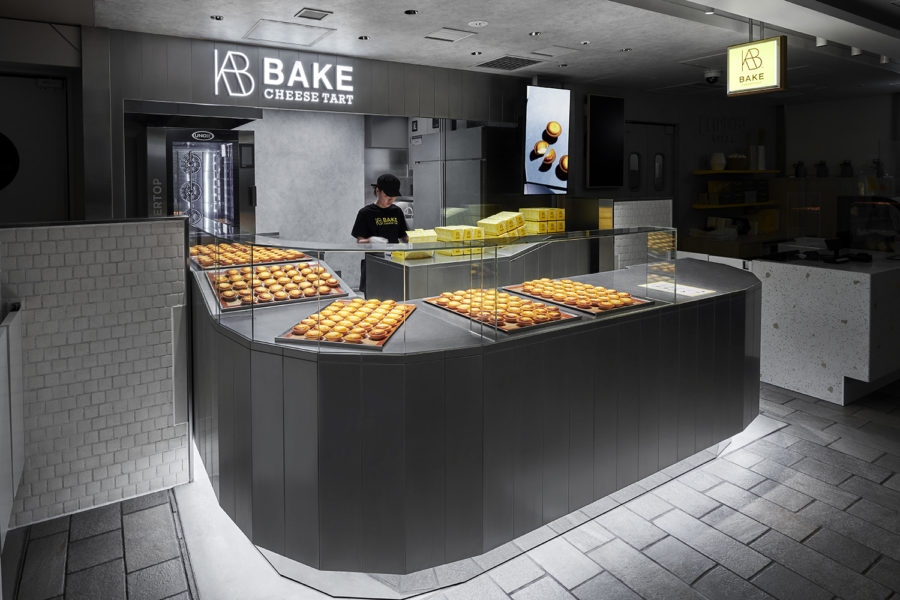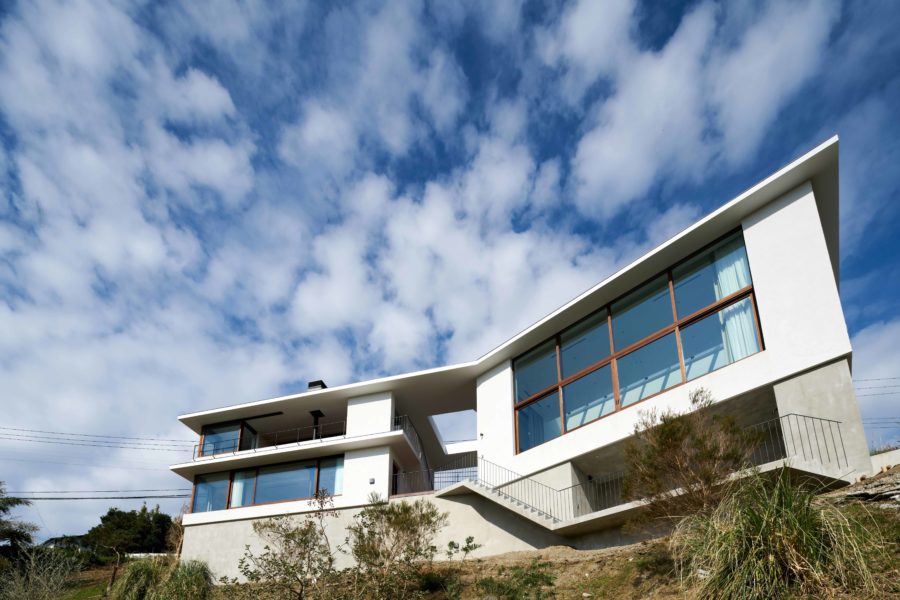住宅の設計において、最も重要なことは、光・風・眺望という3つの要素を住空間に取り込むことである。しかし、住宅が密集する現代の住宅街においては、開放性の獲得とプライバシーの確保の両立は難しい。また現代の都市住宅においては、住空間の中に仕事場や収納など多くの機能が求められるようになったため、各機能を配置しながら快適な住空間を構築することも重要である。
敷地は、坂道の多い川崎市の住宅街の中にある。両隣に民家が建ち並び、北側には桜の巨木が印象的な公園が、南側には立派なクスノキが植えられた日本風の庭園が残されていた。2人の子供がいる30代夫婦のクライアントからは、シンプルで機能的な空間、天井が高く開放的な空間、職住一体のワンルーム空間、プライバシーの保たれた空間が求められた。私は、既存の環境を手掛かりに、プライバシーを保ちつつ、豊かな緑に囲まれた開放的な職住一体の空間形式をどのように構築するかを考えることから設計を始めた。
まず、公園と庭園という緑の環境を住空間に取り込むため、南北に2つの吹き抜け空間を設け、1階をリビング・ダイニングとし、それぞれをモルタル床の土間空間で繋いだ。リビングは天井高5mの開放空間で、家族全員が座れる造作ソファから北側の公園の桜の巨木が望める。
ダイニング空間の両脇には、南側の庭が望める仕事部屋とキッチンを設け、グレーチングや家具で空間を緩やかに分けた。庭は、日本庭園風の石組みや樹木を取り除き、クスノキを残して芝生を張り、アウトドア好きな家族が積極的に外へ出られる庭に改修している。また、収納・水回りなどの煩雑になりがちなバックヤードを、すべて東側の1カ所にサービスコアとしてまとめ、生活空間の快適性が損なわれないようにした。
こうして1階を、天井の高い土間スタジオのような構成とすることで、南北の豊かな緑に囲われながら、家族が活動できる職住一体のワンルーム空間とした。
リビングから吹き抜けを介し、鉄骨の回り階段で2階に上がると、水回りと、家の出隅部分に3つの寝室があるプライベート空間になっている。寝室が吹き抜けに面する壁面に室内小窓を設け、各寝室から吹き抜け下のリビング・ダイニングの様子が見えると同時に、南北の緑への景観を寝室からも享受できるようにした。
そして、プライバシーを確保しつつ、光・風・眺望を住空間に取り込む方法として住宅の4つの出隅を切り取り、45度方向に開けた窓を設ける方法を採用した。そうすることで、すべての部屋から隣家の気配を気にすることなく眺望が45度に開け、実際以上の広がりを感じられるようになった。この45度方向の開口は、住宅が密集する市街地でも適用できる方式だと考えている。
リビング吹き抜けの北側の窓からは、公園に立つ桜の巨木が四季折々の表情を見せ、ダイニング吹き抜けの南側の窓からは、クスノキの木漏れ日と風が室内に入り込み、このワンルーム空間に豊かさと変化を与えている。
私が意図した空間形式が、移りゆく四季の変化とともに、日々忙しない家族の暮らしに穏やかさと彩りを与えてくれることを望んでいる。(岡田一樹・岡田絢子)
A modern urban house with manipulated windows to enjoy the four seasons
In residential design, the most important thing is to incorporate the three elements of light, wind, and views into the living space. However, in today’s densely populated residential areas, it isn’t easy to achieve both openness and privacy. In addition, modern urban housing requires many functions in the living space, such as workspace and storage, so it is important to construct a comfortable living space while arranging each function.
The site is located in a residential area of Kawasaki City with many slopes. The client, a couple in their 30s with two children, requested a simple and functional space, an open space with high ceilings, a one-room space that integrates work and residence, and a space that maintains privacy. The client, a couple in their 30s with two children, wanted a simple, functional space, an open space with high ceilings, a one-room space for work and living, and privacy. I began the design process by taking the existing environment as a starting point and considering how to construct a spatial form that integrates work and residence in an open space surrounded by abundant greenery while preserving privacy.
First, in order to incorporate the green environment of the park and garden into the living space, two atrium spaces were created on the north and south sides, with the living and dining rooms on the first floor, each connected by an earthen floor space with a mortar floor. The living room is an open space with a 5-meter-high ceiling, where the whole family can sit on a sofa overlooking the huge cherry blossom trees in the park to the north.
On either side of the dining space, a workroom and kitchen with a view of the garden to the south are located, and the space is gently divided by grating and furniture. The garden was renovated by removing the Japanese garden-style masonry and trees, leaving the camphor tree in place, and covering it with grass to create a garden where the family, who love the outdoors, can actively go outside. In addition, the backyard, which tends to become cumbersome in terms of storage and water supply, was all consolidated into a single service core on the east side so that the comfort of the living space is not compromised.
The first floor is thus configured as a studio with a high-ceilinged earthen floor, creating a one-room space that integrates work and residence, where the family can be active while being surrounded by lush greenery to the north and south.
From the living room, a steel staircase leads up through the atrium to the second floor, where there is a water closet and three bedrooms in the corner of the house, which are private spaces. The bedrooms face the stairwell and have small interior windows on the walls so that each bedroom can see the living and dining rooms below the stairs, and at the same time, the bedrooms can enjoy the view of the greenery to the north and south.
In order to bring light, wind, and views into the living space while maintaining privacy, we cut out the house’s four corners and installed windows that open at 45 degrees. By doing so, all rooms have a 45-degree view without worrying about the presence of neighbors, giving the house a more expansive feel than it actually is. We believe that this 45-degree opening is a method that can be applied even in urban areas where houses are densely built.
From the north window of the living room atrium, a huge cherry tree standing in the park shows its seasonal expression. From the south window of the dining room atrium, sunlight and breezes from the camphor tree filter into the room, adding richness and change to this one-room space.
I hope that the spatial form I intended to create, along with the changing seasons, will bring serenity and color to the lives of my family, who are not always busy with their daily routines. (Kazuki Okada, Ayako Okada)
【HAUS_M】
所在地:神奈川県川崎市
用途:戸建住宅
クライアント:個人
竣工:2021年
設計:R.E.A.D. & Architects
担当:岡田一樹、岡田絢子
構造設計:佐藤岳人(TS構造設計)
庭園:西村直樹(西村工芸)
設備:R.E.A.D. & Architects
施工:瀬戸建設
撮影:Nao Takahashi
工事種別:新築
構造:木造
規模:地上2階
敷地面積:178.69m²
建築面積:69.59m²
延床面積:120.06m²
設計期間:2019.08-2020.08
施工期間:2020.08-2021.02
【HAUS_M】
Location: Kawasaki-shi, Kanagawa, Japan
Principal use: Residential
Client: Individual
Completion: 2021
Architects: R.E.A.D. & Architects
Design team: Kazuki Okada, Ayako Okada
Structure engineer: Taketo Sato / Taketo Sato structural design
Gardening: Naoki Nishimura / Nishimura Garden Craft
MEP engineer: R.E.A.D. & Architects
Contractor: Setokensetsu Inc.
Photographs: Nao Takahashi
Construction type: New Building
Main structure: Wood
Building scale: 2 stories
Site area: 178.69m²
Building area: 69.59m²
Total floor area: 120.06m²
Design term: 2019.08-2020.08
Construction term: 2020.08-2021.02








